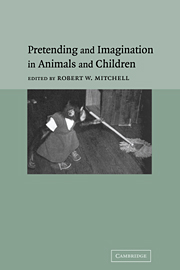Book contents
- Frontmatter
- Contents
- List of contributors
- Foreword by Sue Taylor Parker
- Preface and acknowledgments
- I Historical, developmental, and comparative overviews
- 1 Imaginative animals, pretending children
- 2 A history of pretense in animals and children
- 3 Pretending as representation: a developmental and comparative view
- II Pretense and imagination in children
- III Pretense and imagination in primates
- IV Prospects
- References
- Author Index
- Subject Index
1 - Imaginative animals, pretending children
Published online by Cambridge University Press: 13 August 2009
- Frontmatter
- Contents
- List of contributors
- Foreword by Sue Taylor Parker
- Preface and acknowledgments
- I Historical, developmental, and comparative overviews
- 1 Imaginative animals, pretending children
- 2 A history of pretense in animals and children
- 3 Pretending as representation: a developmental and comparative view
- II Pretense and imagination in children
- III Pretense and imagination in primates
- IV Prospects
- References
- Author Index
- Subject Index
Summary
Could one imagine a world in which there could be no pretence?
(wittgenstein, 1949/1992, p. 37e)This book is a delightful collection of scientific writings about pretending and imagination in animals and children. The impetus for the present volume derives not only from observations of animals' activities similar (perhaps identical) to pretense (e.g., Groos, 1898; Mitchell & Thompson, 1986; Mitchell, 1987, 1990, 1991a, 1993c, 1994a; Byrne & Whiten, 1990; Miles, 1991; Russon, 1996), but also from developing ideas about children's understanding of pretense (Harris & Kavanaugh, 1993; Lillard, 1993a,b, 2001a), philosophy of art (Walton, 1990), and the evolution of image-making (Davis, 1986), all of which concern organisms' understanding or creating reproductions of various sorts (Mitchell, 1994a). The continuing influences of Piaget (1945/1962), Guillaume (1926/1971), Bateson (1955/1972, 1956), Vygotsky (1930–1966/1978), and Leslie (1987) are also apparent. The purpose of the book is primarily to present and examine evidence for the existence and nature of pretense in animals and children, and secondarily to examine various aspects of why or how. Evidence of pretense in animals may eventually allow us to provide a “psychologically and evolutionarily plausible account of ‘fictive acts of perceiving’” (Davis, 1986, p. 211; see Mitchell, 1994a; Reynolds, PIAC14). A full appreciation of what needs to be incorporated into such an account is provided by reading chapters in this volume, in which the topics range from relatively simple simulative actions to complex fantasizing about nonexistent objects and agents.
- Type
- Chapter
- Information
- Pretending and Imagination in Animals and Children , pp. 3 - 22Publisher: Cambridge University PressPrint publication year: 2002
- 1
- Cited by

